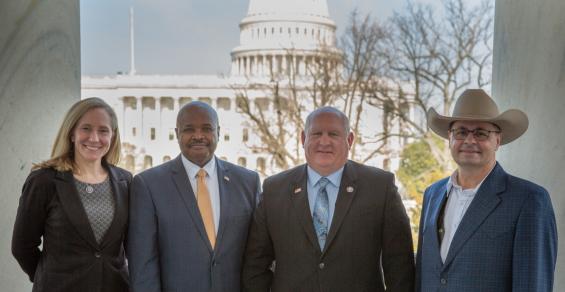Five things we heard during two recent House Agriculture Committee hearings on the 2018 Farm Bill.
The current farm bill expires in 2023, leading those on Capitol Hill to begin its work of oversight of the 2018 Farm Bill. During hearings in early February, Robert Bonnie, undersecretary for Farm Production and Conservation, as well as Farm Service Agency Administrator Zach Ducheneaux and Natural Resources Conservation Service Chief Terry Crosby each offered their insight into what has worked well and opportunities to improve conservation programs as well as other tenets of the current farm bill.
In his opening statement to Bonnie, House Agriculture Committee Ranking Member Glenn “GT” Thompson, R-Pa., says in his opinion the committee is “a bit behind in our oversight responsibilities and will need to get up to speed on these issues quickly if we are going to complete a farm bill on time next year.”
In addition to concerns about funds to target climate practices, Thompson called on Bonnie to help in the discussion on both Title 1 traditional commodity programs and crop insurance as both are under Bonnie’s FPAC mission area.
Here are five things we heard that piqued our interest in the debate moving forward.
Build Back Better tried to double conservation funding. Thompson criticized the stalled Build Back Better bill’s attempt to double funding for farm bill conservation programs without any oversight hearings on whether those farm bill conservation programs need changes. Some lawmakers voiced concerns with the Biden administration’s laser focus on climate-related ag practices while touting the importance of programs like Conservation Security Program, Environmental Quality Incentive Program, and Conservation Reserve Program for growers. Many bipartisan members of the committee echoed the position held by many of those in agriculture that there are no one-size-fits-all policies when it comes to conservation, so the programs need to allow for local tailoring.
CRP seen as working lands. Although the Conservation Reserve Program has typically been considered an idling lands program, Ducheneaux says he believes changes made to allow for emergency CRP grazing and even baling of those resources allows for producers to stockpile that forage in drought-stricken areas. “Hay in the stack is like money in the bank,” Ducheneaux says. Stockpiling forage that still considers key primary nesting periods for specific wildlife allows the program to better position itself to offer feed resources when needed and move beyond just “idled” land.
In the last farm bill, Congress reduced rental rates for CRP and capped acres at 25 million acres for 2021, with incremental increases in that cap to 27 million by FY23. Prior to last year CRP enrollments were down, which led FSA to increase rental rates for its grassland CRP rates by $15 per acre in 1,300 counties and also added a climate-smart practice incentive for CRP general and continuous signups to encourage additional enrollment.
Rep. Dusty Johnson, R-S.D., questioned how these changes are impacting young farmers vying for land. Ducheneaux says CRP does have some limits built into the program to encourage enrollment in the most highly erodible lands. In addition, only 25% of land in a county can qualify for CRP, leaving 75% of potential land available for production. He says there are opportunities to provide transition incentive programs within CRP to help make that transfer of land to the next generation, he says.
Public private crop insurance partnership crucial. Rep. Angie Craig, D-Minn., reiterated that she consistently hears the federal crop insurance program works well and the program does not need changes. Bonnie says maintaining the public private partnership is critically important and “remains vital” to producers managing risk. Even with the increase in disaster ad hoc assistance in recent years, USDA has linked participation with crop insurance to incentivize producers to utilize those programs.
“As we look at the future of crop insurance, we’ve developed a lot of programs, and we’ll continue to look for ways and gaps in coverage where we can create new products and new opportunities in that partnership,” Bonnie says. The last farm bill offered whole farm insurance and micro-farm insurance policies to expand on traditional offerings.
USDA recently rolled out a Post Application Coverage Endorsement – PACE – in certain states for corn farmers who split apply nitrogen. Bonnie says this is one of many ways the public private partnership is coming together to create new products that create incentives that in this case also offer environmental and economic benefits.
Climate-smart pilot projects offer crucial insight. USDA announced $1 billion in Commodity Credit Corporation funds to offer grants to pilot projects of varying sizes to work directly with producers and the private sector on establishing climate-smart commodities. Bonnie says this area is “ripe for improvement” in building on funding offered through the Regional Conservation Partnership Program to partner together private dollars with taxpayer dollars.
Bonnie says with this pilot program USDA hopes to provide learning and create a conversation on incentives, measurement and verification of climate-smart practices that eventually will provide new revenue streams for farmers. Despite questions on whether CCC funds can be directed by USDA without Congressional direction, Bonnie defended the action because it supports ag markets similar to the way CCC funds were used during the pandemic and trade war.
Staffing levels still low at USDA. Many members questioned the USDA officials about staff on the ground that interface with producers. Bonnie was quick to note, “We need more people at NRCS and FSA,” he says.
Cosby says NRCS has an aggressive hiring strategy and has been able to hire 3,000 employees in the last two years. They’re working closely with state conservationists to fill the remaining 700 needed staff positions. Bonnie adds when looking towards the next farm bill, NRCS will need more “boots on the ground” to provide sound technical insight as well as outreach to small, medium and historically-underserved farmers.
No need to create a climate title. Committee Republicans emphasized that the conservation title must not be repurposed as a climate title when the farm bill is reauthorized in 2023, and the many practices and actions encouraged in other farm bill titles that improve overall farm sustainability cannot be forgotten. House Agriculture Committee Conservation and Forestry Subcommittee Chairman, Abigail Spanberger, D-Va., vowed the title would remain the “conservation title,” although she praised the ability for Congress to focus dollars that offer climate-smart benefits and ensure farmers stay on the land through economic sustainability within that title.






